 Can we change our tuna?With the Atlantic bluefin tuna fishery on the verge of collapse and ICCAT, the entity charged with protecting it, ignoring its own scientists’ call for a fishing ban, the tuna’s last hope appears to be a March 2010 meeting of an international wildlife management group. Marine biologists and fisheries experts (along with eaters, I should point out) hope that this group — the Convention on International Trade in Endangered Species of Wild Flora and Fauna (CITES) — will put the Atlantic bluefin tuna on its Appendix I list of endangered species. If the tuna gets on that list, all international trade in the fish will be banned, effectively closing the tuna fisheries, which should allow the fish to recover eventually.
Can we change our tuna?With the Atlantic bluefin tuna fishery on the verge of collapse and ICCAT, the entity charged with protecting it, ignoring its own scientists’ call for a fishing ban, the tuna’s last hope appears to be a March 2010 meeting of an international wildlife management group. Marine biologists and fisheries experts (along with eaters, I should point out) hope that this group — the Convention on International Trade in Endangered Species of Wild Flora and Fauna (CITES) — will put the Atlantic bluefin tuna on its Appendix I list of endangered species. If the tuna gets on that list, all international trade in the fish will be banned, effectively closing the tuna fisheries, which should allow the fish to recover eventually.
And in the first step in this process, the UN’s Food and Agriculture Organization convened an expert panel to consider such an Appendix I proposal for the bluefin tuna — the panel’s recommendation being in effect a necessary pre-condition to an official listing by CITES. And the tuna passed! A majority of the panel approved the proposal recommending CITES give the bluefin tuna Appendix I protection. Yay!
But wait. There’s a problem.
The FAO buried the announcement in a pile of bureaucratic doublespeak which has left even supporters of the bluefin confused. It turns out that there are multiple appendices in the CITES treaty — and the panel also voted (in this case unanimously) that the tuna qualified for Appendix II to go along with its majority vote on the Appendix I listing. Appendix II, it turns out, is typically a stepping-stone listing — it doesn’t provide nearly as much protection as Appendix I. Trade in Appendix II fish must simply be “monitored and regulated.” But monitoring and regulation has so far done nothing to stop the bluefin’s slide to extinction. With some of the main problems for the tuna being excess catches and gray market trade, nothing but an outright trade ban is likely to save the fish.
So what’s the deal? Did the panel favor one appendix listing over another? Will the tuna get recommended for the full protection of Appendix I or the partial and probably insufficient protection of Appendix II when CITES meets in the spring? Is the bluefin tuna doomed or not?
To find out, I asked Sue Lieberman, director of international policy for the Pew Environmental Group, which has been deeply involved in the campaign to save the Atlantic bluefin. She assured me that the headline here, despite the FAO’s fumbling announcement, is that the panel did endorse an Appendix I listing by CITES. The population numbers provided by ICCAT’s own scientists in addition to others qualify the fish for protection — and that’s what the FAO panel vote means.
She assured me that the minority opposed to the listing was “very small” and that the FAO would release a detailed statement next week. Further, there was nothing in the proposals about favoring Appendix II over Appendix I. The fact that the Appendix II vote was unanimous is simply a reflection of the lower bar. “It wasn’t a preference” for Appendix II, Lieberman said. The bluefin’s winning a recommendation from the panel is “a landmark” according to Lieberman and if CITES comes through the bluefin will become the first commerically exploited fish to receive an Appendix I listing. Ever.
For, in the end, what matters is what happens in March at the CITES meeting. But the FAO has at least provided a glimmer of hope that the Atlantic bluefin tuna can be saved.



